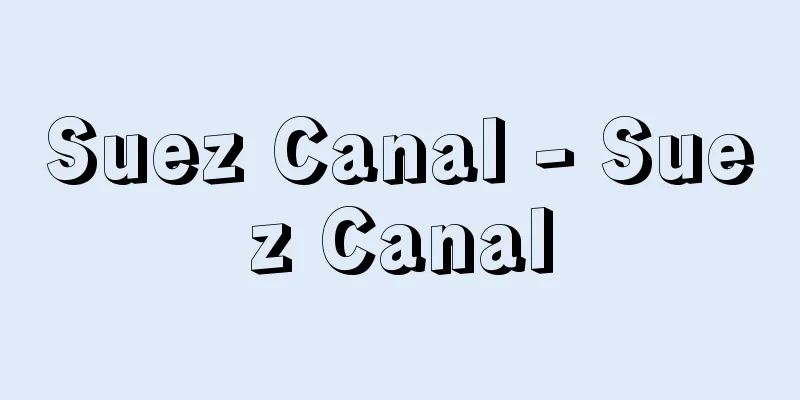Suez Canal - Suez Canal

|
It is the world's largest horizontal marine canal, connecting the Mediterranean Sea with the Gulf of Suez, the Red Sea, and the Indian Ocean, and runs through the Isthmus of Suez, which is a strait between Asia and Africa. The isthmus is 162.5 km long, and the total length including the north-south approach waterways is 195 km. [Denroku Sakai and Satoshi Suzuki] historyThe history of the Suez Canal is greatly influenced by its role as a hub where the world's transportation, as well as the political, economic, and military aims of various countries, intersected. The Suez Canal was first built around 2000 BC, when King Senusret I of the 12th Dynasty of Ancient Egypt dug the canal to secure drinking and agricultural water, connecting the Nile River and the Red Sea. The canal's course is said to have started from Zagazig, a strategic location on a tributary at the eastern end of the Nile, traveled eastward through the Wadi Tumilat depression, entered Lake Timsah, and then traveled south through the Bitter Lakes to the Gulf of Suez and the Red Sea (there is also a theory that it was built around 600 BC, but according to this theory, King Necho II of the 26th Dynasty built it but abandoned it midway, and King Darius I of the 27th Dynasty took over and completed it). The canal was used continuously after that, but was abandoned and filled with silt after the 8th century for political and military reasons. In the 15th century, when a sea route around the Cape of Good Hope was discovered and East-West trade along this route became active, the Venetians, the most energetic trading people in the Mediterranean, proposed to the Sultan of Egypt that they dig the Isthmus of Suez to create a short route directly connecting the Mediterranean Sea and the Red Sea, but were rejected. However, this idea continued to attract Europeans on various occasions thereafter. On December 30, 1798, Napoleon's Suez inspection team discovered the remains of an ancient canal connecting the Nile River and the Red Sea. This prompted a survey team led by architect Le Père to carry out various surveys of the Isthmus of Suez to explore the possibility of building a direct canal connecting the Mediterranean Sea and the Red Sea. However, they misjudged the difference in water levels between the two seas to be 9.9 meters, which led to the abandonment of the construction plan. However, this first professional survey in human history stimulated the enthusiasm of the French Ferdinand de Lesseps, who was appointed as the Consul-General of Egypt in 1832. Furthermore, in 1847, a survey by engineer Linan Bey reported that there was almost no difference in the water levels of the two seas. After leaving his diplomatic career as ambassador to Rome in 1849, Lesseps had been working on the idea of a direct canal. In 1854, Said Pasha became governor, which marked the first step in making the direct canal a reality. Said Pasha had studied French and culture under Lesseps as a boy, and the two had a special friendship. Lesseps seized this opportunity to put the construction of the direct canal into action. On November 30 of the same year, Lesseps received a construction permit from the governor. The permit included basic conditions such as the term of the rights of the Universal Suez Marine Canal Company (99 years) to be established, and the canal's international non-discrimination and free navigation. The British launched a strong opposition campaign against this plan, fearing that it would threaten British interests from Egypt to East India, and also because they had begun construction of a railway linking Alexandria, Cairo, and Suez in 1850. The Governor-General of Egypt and the Ottoman Sultan, the country's overlord, received various forms of pressure from the British, and the Sultan was reluctant to issue a final construction permit, leading to frequent crises in the plan. However, Lesseps established the Suez Canal Company on December 15, 1858, and held a groundbreaking ceremony at the starting point on the Mediterranean side (today's Port Said) on April 25 of the following year, without waiting for the Sultan's permission. British interference continued, leading to a conflict between the Sultan and the Suez Canal Company, and even leading to the Governor-General of Egypt issuing an order to halt construction. The situation was improved by the mediation of Napoleon III (1864), and a new agreement was signed in 1866. In this agreement, it was clearly stated for the first time that "the Suez Canal Company is an Egyptian company, and is governed by Egyptian law and customs." In the same year, the final construction permit was issued by the Turkish Emperor. Thus, the canal was opened, and on November 17, 1869, a grand opening ceremony was held, inviting heads of state and dignitaries from around the world. When the Suez Canal was opened in 1869, the British Liberal Party's Gladstone Cabinet (1868-1874) supported Lesseps, recognizing its world-historical value in a fair manner, whereas the Palmerston Cabinet, also of the Liberal Party, had strongly opposed its construction. The Foreign Secretary sent Lesseps a telegram of praise and congratulations. The "British hostility" that had been the greatest nuisance for Lesseps since 1855 ended at this time, and since then Britain has become the largest user of the canal and has had a say in the canal company. In 1875, when Viceroy Ismail Pasha of Egypt put up for sale 177,000 shares of the Canal Company for financial reasons, Britain did not hesitate to buy them. This was nearly half of the total of 400,000 shares in the company. The series of events that followed, including the growing deficit of the Egyptian treasury (1876), the control of Egyptian finances by Britain and France (1878), and the forced abdication of Viceroy Ismail (1879), on the one hand encouraged cooperation between Britain and France, and on the other hand ignited the national consciousness of the Egyptian people. As a result, anti-European riots broke out in Alexandria in 1882, and the army under the command of nationalist soldier Orabi Pasha intervened, resulting in the deaths of about 50 Europeans. Britain sent troops to Egypt under the pretext of ensuring the safety of Europeans and the passage of the Suez Canal, and occupied the Suez Canal area, prohibiting passage for two days. The ban was lifted only after strong protests by Lesseps, but this led to widespread recognition of the need for an international agreement on freedom of navigation, and in 1888 a treaty was signed by nine European powers in Constantinople (now Istanbul). All nations ratified the treaty immediately, except for Great Britain, which delayed its ratification due to its military occupation. It was not until the signing of the Anglo-French Entente in 1904 that the treaty came into full effect after Britain's ratification. British occupation continued, and the canal was closed for one day during World War I and intermittently for a total of 76 days during World War II. Britain also legalized its garrison rights in the Suez Canal Zone through the Anglo-Egyptian Treaty of 1936. In response, Lt. Colonel Nasser, who emerged during the Egyptian Revolution of 1952, and General Naguib, who became president and prime minister in June 1953, had Britain approve an agreement for an early withdrawal (1954), and the withdrawal based on this agreement was completed in June 1956, and the canal zone returned to Egyptian sovereignty for the first time in 72 years. On July 19, 1956, the United States notified Egypt that it would withdraw its loan for the Aswan High Dam, and the United Kingdom and the World Bank followed suit. On the 26th of the same month, President Nasser announced the nationalization of the Suez Canal Company (which had contractual rights until 1968) and that the profits from the company would be used to build the Aswan High Dam. This prompted an attack on Egypt by Britain, France, and Israel (the Suez War or the Second Arab-Israeli War), but due to Egyptian resistance and the intervention of the United Nations, the British, French, and Israeli troops withdrew, the nationalization was confirmed, and Egypt paid compensation to the former company. The canal was closed for five months due to the Suez War. It was closed again during the Six-Day War in June 1967, and reopened in June 1975 after an eight-year hiatus after the Fourth Arab-Israeli War. In November of the same year, the first expansion work began, which was completed in December 1980. A second expansion was planned, but the Iran-Iraq War (1980-1988), the Gulf Crisis and the Gulf War (August 1990-February 1991), and other events put the plan on hold. However, in late July 1991, the Egyptian government asked the World Bank and Japan for financial assistance to realize the second expansion plan, and the second expansion work that was carried out thereafter made it possible for mammoth tankers to navigate the canal. In 1996, the Egyptian government announced the Suez Canal Bridge Plan, and Japan agreed to provide a total of 11.8 billion yen in grant aid over four years. In May 1998, a consortium of three companies, Kajima Corporation, Nippon Kokan (now JFE Steel), and Nippon Steel (now Nippon Steel & Sumitomo Metal), signed a contract with the Egyptian government to build the bridge. The bridge spans the Suez Canal, connecting Egypt, Gaza, and Israel, and is about 4 kilometers long, with a bridge section of about 730 meters. It was completed in 2001. [Denroku Sakai and Satoshi Suzuki] Economic significanceWith the opening of the canal in 1869, the distances were significantly shortened compared to the route around the Cape of Good Hope in South Africa. The distance between Liverpool and Bombay (now Mumbai) was shortened by 42%, and the distance between Liverpool and Yokohama by 24%, which reduced the number of days and costs of transport accordingly. This was the time when steamships were replacing sailing ships, and the number of ships passing through the canal increased year by year. In 1869, only 10 ships passed through the canal, but by 1873, the number had exceeded 1,000. The number of ships passing through the canal continued to increase, reaching 10,000 ships in 1976, 20,000 ships in 1977, and 22,811 ships in 1982, with a daily passing volume of 62.5 ships. The amount of cargo carried also increased accordingly, and the canal plays a major role in the exchange of goods between the East and the West. Before the Second World War, the main cargo was food, raw materials, and industrial products, but after the war, the proportion of oil on the canal increased dramatically, and the number of oil tankers passing through the canal reached 69 ships in 1975, 2,000 ships in 1977, 3,000 ships in 1981, and 3,602 ships in 1983. Most of the oil consumed in Europe is transported through the canal. On the other hand, the economic impact of shipping tolls on Egypt was large, with revenues of $99 million in 1975 rising to $587 million in 1979, $956 million in 1982, and approximately $1.9 billion in 1994. Shipping tolls are an important source of foreign currency earnings for Egypt, along with remittances from Egyptian workers abroad and exports. Thus, the words of Lesseps to the Egyptian workers at the groundbreaking ceremony rang true: "You are carrying more than just dirt; you are carrying prosperity to your homes and to this beautiful country." [Denroku Sakai and Satoshi Suzuki] History from the perspective of construction technologyThe Suez Canal is a 162.5 km horizontal canal that was excavated through the Isthmus of Suez to connect the Mediterranean Sea to the Red Sea. The first professional survey was carried out by Le Père at the end of the 18th century under the orders of Napoleon, and the results of this survey showed that the Red Sea was 9.9 meters higher than the Mediterranean Sea. Mathematicians J.B. Joseph Fourier and Pierre Simon Laplace, who were part of Napoleon's survey, argued that the two seas should be at the same level physically. However, this measurement bound scholars and engineers for the next 50 years. Then, in 1845, engineer Linan Bey surveyed the Isthmus of Suez and reported in 1847 that there was almost no difference in water level between the Mediterranean Sea and the Red Sea. In October 1855, the International Commission for the Survey of the Suez Canal was formed in Paris, and on April 25, 1859, a groundbreaking ceremony was held at the tip of the Mediterranean Sea. This project was a grand dream, but there were few innovative attempts in civil engineering. The highest point of the excavated land was only 15 meters above sea level, about one-fifth of the canal was natural lake water, and the route was monotonous, with the northern part being almost straight. The soil was sand and clay, which made it possible to excavate it by hand, so from the start of construction in 1859 until 1863, the then Egyptian governor, Said Pasha, provided about 25,000 laborers per month, and the soil was transported by camel. However, after the governor-general was replaced by Ismail Pasha, and in 1863 the Turkish foreign minister made a request to Lesseps to abolish forced labor, reduce the number of laborers from 25,000 to 6,000, and raise the laborers' wages, the introduction of machinery was actively promoted after that. The most typical example of this was 60 steam-engine bucket dredgers, which had 70-meter-long chutes that could pile up the swept soil on both sides of the river. However, the joining of the two seas was not a simple matter. The waves and impacts that accompanied the joining were greater than expected. This was because the water level of the Mediterranean Sea was 25 centimeters lower than that of the Red Sea. The dikes collapsed in many places, and the difficult work of reinforcing and rebuilding them continued amidst uncertainty. On August 18, 1869, the movement of the water finally stabilized. Thus, the Suez Canal was completed on November 17 of the same year, after the excavation of a total earthwork volume of about 75 million cubic meters. However, behind the scenes, it is said that more than 120,000 people were killed. Its cross section is a thin trapezoid, and when it was first opened in 1869, it was 22 meters wide, 8 meters deep, and had a draft of 5 meters. It was gradually expanded, and by 1956, when the Suez Canal Company was nationalized by Egypt, it was 171 kilometers long, 13 to 15 meters deep, and 140 meters wide at the water surface, with a draft of 11 meters and a width of 60 meters, and in some areas exceeding 100 meters. The first phase of expansion work was started by the Egyptian government in November 1975, and was completed in December 1980 with assistance from Japan and other countries. At the completion ceremony of this work, President Sadat praised Japan's cooperation, saying, "This widening and deepening plan was made possible thanks to Japan's contributions, including technology, construction, and funds." As a result of this work, the depth was 19.5 meters and the width was 160 meters, making it possible for tankers with a crude oil capacity of 150,000 tons to pass through. The Egyptian government then carried out the second phase of expansion work, which made it possible for mammoth tankers to pass through. Expansion work continued in 1994, 1996, and 2001, and as of 2010 the canal was 193.30 kilometers long, 24 meters deep, and 205 meters wide, allowing tankers with a crude oil capacity of 240,000 tons to pass through. [Hideo Igarashi and Satoshi Suzuki] “Suez Canal” by Denroku Sakai (1992, Asahi Shimbun) ▽ “Dictionary of Civil Engineering Terms” edited by Japan Society of Civil Engineers (1999, Gihodo Publishing)” [References] | | | | | | Sea | | | |The world's largest horizontal ocean canal, connecting the Mediterranean Sea and the Red Sea. It was opened in 1869. After several expansion works, it became possible for tankers carrying 240,000 tons of crude oil to pass through. Egypt ©Shogakukan "> Suez Canal Source: Shogakukan Encyclopedia Nipponica About Encyclopedia Nipponica Information | Legend |
|
地中海とスエズ湾、紅海、そしてインド洋を結ぶ世界最大の水平海洋運河で、アジアとアフリカの海峡をなすスエズ地峡を貫く。地峡部の長さは162.5キロメートル、南北の進入用水路設備を含めると全長195キロメートル。 [酒井傳六・鈴木聡士] 歴史スエズ運河の歴史は、世界の交通、そして各国の政治・経済・軍事等のさまざまな思惑が交錯する結節点であったことに大きく影響されている。スエズ運河の最初の建設時期は、紀元前2000年ごろといわれ、古代エジプト第12王朝の王センウスレト1世が飲料・農業用水の確保などを目的として運河を掘り、ナイル川と紅海を結び付けたとされる。このコースは、ナイル東端の支流の要地ザガジグに発し、ワディ・ツミラト凹地を東進してティムサ湖に入り、ついで南下してビター湖を経て、スエズ湾、紅海に達するものであったといわれている(紀元前600年ごろに建設されたという説もあるが、これによると、第26王朝の王ネコ2世が建設したが途中で放棄し、それを第27王朝の王ダリウス1世が引継ぎ完成させたという)。 この運河はその後継続的に活用されたが、政治および軍事的理由などにより8世紀以降放置されて土砂に埋まった。15世紀に喜望峰回りの航路が発見されて、この航路による東西交易が活発になると、地中海のもっとも精力的な通商民族ベネチア人が、スエズ地峡を掘って地中海と紅海を直結する短距離経路をつくるようエジプトのスルタンに提案したが拒否された。しかしその後、この考えはことあるごとにヨーロッパ人をひきつけた。 1798年12月30日、ナポレオンのスエズ地区視察隊はナイル川と紅海を結ぶ古代運河の跡を発見した。このことがきっかけとなり、地中海と紅海を結ぶ直行運河の建設の可能性を探るため、建築家ル・ペール率いる調査隊がスエズ地峡部のさまざまな調査を行ったが、その結果、二つの海の水位差を9.9メートルであると見誤り、この報告によって建設を断念するに至った。しかし、この人類史上初の専門的調査が、1832年にエジプトへ領事代理として赴任したフランス人フェルディナン・ド・レセップスの気持ちを刺激した。さらに1847年、技師リナン・ベイの調査によって二つの海の水位差はほとんどないということが報告された。 1849年に駐ローマ大使を最後に外交官生活を離れたレセップスは直行運河の構想を進めていた。そして1854年、サイード・パシャが総督に即位し、このことが直行運河実現の第一歩となった。サイード・パシャは少年時代、レセップスを教師としてフランス語と文化を学んでおり、レセップスと特別の友好関係にあった。そしてレセップスはこの機会をとらえて直行運河の建設を実行に移した。同年11月30日、レセップスは総督から建設許可書を受け取った。この許可書のなかには、設立される万国スエズ海洋運河会社の権利期限(99年間)や、運河の国際無差別性と自由航路などの基本条件が示された。 この計画に対してイギリスは、エジプト以東インドに至るイギリスの権益が脅かされるとの不安から、さらには1850年にアレクサンドリア―カイロ―スエズを結ぶ鉄道建設を始めていたことなどから強硬な反対運動を始めた。エジプト総督と宗主国のオスマン・トルコ皇帝はイギリスからさまざまな形の圧力を受けたために、トルコ皇帝が最終的工事許可書を出ししぶり、計画はしばしば危機に見舞われた。しかしレセップスは1858年12月15日スエズ運河会社を設立し、トルコ皇帝の許可を待たずに翌年4月25日に地中海側の出発点(今日のポート・サイド)で起工式を行った。イギリスの妨害はやまず、このためトルコ皇帝とスエズ運河会社が対立し、さらにはエジプト総督も工事中止命令を出した。この事態はナポレオン3世の仲裁(1864)によって改善され、1866年に新たな協定が調印された。この協定のなかで初めて「スエズ運河会社はエジプトの会社であり、エジプトの法と習慣で律せられる」という内容が明記された。また同年、トルコ皇帝の最終工事許可書が発行された。かくして運河は開通し、1869年11月17日、世界諸国の元首、貴顕名士を招いて盛大な開通式が行われた。 1869年スエズ運河が開通した当時、イギリスの自由党グラッドストーン内閣(1868~1874)は、かつて同じ自由党のパーマストン内閣がその建設に強硬に反対を唱えていたのに対し、公平にスエズ運河の世界史的価値を認めてレセップスを支持した。外務大臣は賞賛と祝賀の電報をレセップスに送った。1855年以来レセップスをもっとも悩ませた「イギリスの敵意」はこのとき終わり、以来イギリスは最大の運河利用国となり、運河会社に発言権を持つようになった。 1875年、エジプト副王イスマーイール・パシャが財政上の理由から運河会社の持株17万7000株を売りに出したときも、イギリスは躊躇(ちゅうちょ)することなくこれを買い入れた。会社全体の40万株の半分に近い数である。続いて起こったエジプト国庫の赤字増大(1876)、イギリス・フランス両国によるエジプト財政の管理(1878)、副王イスマーイールの強制退位(1879)と続く一連のできごとは、一方でイギリス・フランス間の協調を促し、他方でエジプト国民の民族意識に火をつけた。その結果、1882年にアレクサンドリアで反ヨーロッパ人暴動が起き、民族主義者である軍人オラビ・パシャの指揮する軍が介入、約50人のヨーロッパ人の死者が出た。イギリスはヨーロッパ人の安全とスエズ運河の通航確保という名目を挙げてエジプトに出兵し、スエズ運河地帯を占拠、通航を2日間禁止した。通航禁止の解除はレセップスの強硬な抗議で実現したが、これを契機として通航の自由に関する諸国間協定の必要が広く認識され、1888年にヨーロッパ列強9か国による条約がコンスタンティノープル(現在のイスタンブール)で調印された。各国はただちに批准したが、イギリスだけは軍事占領のために批准を延ばした。イギリスの批准が終わり条約が有効に機能するようになったのは1904年のイギリス・フランス協商調印後である。その後もイギリスの占領は続き、第一次世界大戦では1日、第二次世界大戦では断続的に計76日間運河が閉鎖された。 イギリスはまた、1936年のイギリス・エジプト条約でスエズ運河地帯の駐留権を適法化した。これに対し1952年のエジプト革命で登場したナセル中佐と、1953年6月に大統領兼首相に就任したナギブ将軍らは、早期撤兵のための協定をイギリスに承認させ(1954)、これに基づいた撤兵が1956年6月に終わって、実に72年ぶりに運河地帯はエジプトの主権下に戻った。 1956年7月19日、アメリカがアスワン・ハイ・ダムへの融資を撤回する旨をエジプトに通告し、イギリスと世界銀行もこれに倣ったため、同月26日ナセル大統領はスエズ運河会社(契約上は1968年まで権利があった)の国有化を宣し、その収益によってアスワン・ハイ・ダムをつくると宣言した。これを契機にイギリス、フランス、イスラエルによるエジプト攻撃(スエズ戦争または第二次中東戦争)が起こったが、エジプトの抵抗と国連の介入によって英、仏、イスラエルの軍隊は撤退し、国有化が確定、エジプトは旧会社に補償金を支払った。運河はスエズ戦争のために5か月間にわたって閉鎖された。1967年6月の第三次中東戦争で運河は再度閉鎖され、第四次中東戦争後の1975年6月、8年ぶりに再開された。さらに同年11月には第1期拡張工事が着手され、1980年12月に完成。引き続き第2期拡張工事が計画されていたが、イラン・イラク戦争(1980~1988年)、さらには湾岸危機と湾岸戦争(1990年8月~1991年2月)などの影響によってこの計画は凍結された。しかしエジプト政府は1991年7月末、第2期拡張工事計画を実現するため、世界銀行と日本に資金援助を求め、その後行われた第2期拡張工事によって、マンモスタンカーの航行も可能になった。さらに1996年エジプト政府は「スエズ架橋」計画を発表、日本はそれに対して4年間で総額118億円の無償資金協力を行うことで合意。1998年5月には、鹿島建設、日本鋼管(現、JFEスチール)、新日本製鉄(現、新日鉄住金)3社の企業連合が、エジプト政府と受注契約を交わした。この架橋は、スエズ運河をまたぎ、エジプトとガザ、イスラエルを結ぶもので、全長約4キロメートル、橋部分約730メートル。2001年に完成した。 [酒井傳六・鈴木聡士] 経済的意義1869年の運河開通に伴って、南アフリカの喜望峰回りの航路に比べて著しく距離が短縮された。リバプール―ボンベイ(現、ムンバイ)間で42%、リバプール―横浜間で24%の短縮となり、その分だけ輸送の日数と経費を減らすことになった。 おりしも帆船から蒸気船に移る時代であったこともあり、通航船の数は年とともに増え、1869年にはわずか10隻の通航であったものが1873年には1000隻を超えた。通航船の数はその後も増え続け、1976年に1万隻、1977年には2万隻台に達し、1982年には2万2811隻を数えて、1日当り62.5隻という通航量に達した。これに伴い積載貨物の量も増え、東西の物資の交流に大きな役割を果たしている。第二次世界大戦前の主要貨物は食料品、原材料、工業製品などであったが、大戦後は石油の占める比率が飛躍的に増大し、オイルタンカーの通航数は1975年に69隻、1977年に2000隻、1981年に3000隻、1983年には3602隻に達し、ヨーロッパで消費される石油の大半がこの水路を通って運ばれている。 一方、通航料金がエジプトに与える経済効果は大きく、1975年に9900万ドルの収益であったものが1979年には5億8700万ドル、1982年には9億5600万ドル、1994年には約19億ドルに達した。通航料金は、在外エジプト人労働者からの送金と輸出品に並び、エジプトの重要な外貨収入源となっている。 このように、レセップスが起工式にエジプト人労働者に向かって言った「あなたがたが運ぶものは、単なる土であるにとどまらないのであります。あなたがたは、家庭とこの美しい国に繁栄を運ぶのであります」ということばは真実のものとなった。 [酒井傳六・鈴木聡士] 工事技術からみた歴史スエズ運河はスエズ地峡部を開削して地中海と紅海を結ぶ全長162.5キロメートルの水平式運河である。 最初の専門的調査は、18世紀末にナポレオンの命令によりル・ペールによって行われたものであるが、この調査の結果では、紅海のほうが地中海よりも9.9メートル高いということであった。これに対しナポレオン調査団に属する数学者のJ・B・ジョゼフ・フーリエとピエール・シモン・ラプラスは、二つの海は物理学的にみて同一水位にあるはずだと主張した。しかし先の測定値は以降50年にわたり、学者と技術者を拘束することとなった。そして1845年、技師リナン・ベイはスエズ地峡を調査し、1847年に地中海と紅海の間に水位差がほとんどないことを報告した。その後、1855年10月にはスエズ運河調査国際委員会がパリで結成され、さらに1859年4月25日、起工式が地中海の突端の地で行われた。 この工事は壮大な夢であったが、土木技術上の目新しい試みはほとんどなかった。掘削した陸地の最高所でも標高15メートルにすぎず、運河の約5分の1は天然の湖水であり、路線も単調で北側はほとんど直線であった。土質は砂や粘土で人力掘削が可能であったため、1859年の工事開始後1863年までは、当時のエジプト総督サイード・パシャにより月々約2万5000人の労務者が提供され、ラクダによる土砂運搬が行われた。しかし、総督がサイード・パシャからイスマーイール・パシャにかわったことや、1863年にトルコの外務大臣からレセップスに対して労務者の強制労働の廃止、2万5000人の労務者を6000人に減らすこと、労務者の給料を上げることなどの申し入れがなされたため、その後は機械の導入が積極的に進められた。その代表的なものは蒸気機関を備えた60台のバケット浚渫(しゅんせつ)機であり、70メートルのシュート(樋(とい))によって、さらった土砂を両岸に積み上げることができた。 しかし、二つの海の合流は単純なものではなかった。合流に伴う波動と衝撃は予想を超えるものであった。それは地中海の水位が紅海のそれより25センチメートル低かったことによるものである。堤防は多くの場所で崩れ、困難な堤防補強と再建工事が不安のなかで続けられた。1869年8月18日、ようやく水の動きが安定した。かくしてスエズ運河は、同年11月17日に約7500万立方メートルの総土工量を掘削して完成した。しかしその陰には12万人以上の犠牲者を出したといわれている。 形状は薄い台形の断面形状であり、1869年の開通当初は、幅22メートル、深さ8メートル、喫水深5メートルであった。その後漸次拡張され、スエズ運河会社がエジプトにより国有化された1956年には延長171キロメートル、深さ13メートルないし15メートル、水表面の幅140メートルで、喫水深11メートルのところの幅は60メートル、ある地区では100メートルを超えていた。1975年11月からはエジプト政府によって第1期拡張工事が着手され、日本などの援助を受けて1980年12月に完成した。この工事の完成記念式典でサダト大統領は、「この拡幅・増深計画は技術、工事、資金を含め、日本の貢献によって実現できた」と日本の協力を讃えた。この工事の結果、深さ19.5メートル、幅160メートルとなり、原油積載量15万トン級のタンカーの通航が可能になった。エジプト政府はさらに第2期拡張工事を実施、これによりマンモスタンカーの航行も可能となった。その後、1994年、1996年、2001年に拡張工事を継続し、2010年時点においては、全長193.30キロメートル、深さ24メートル、幅205メートルとなり、原油積載量24万トン級のタンカーの通行が可能となった。 [五十嵐日出夫・鈴木聡士] 『酒井傳六著『スエズ運河』(1992・朝日新聞社)』▽『土木学会編『土木用語大辞典』(1999・技報堂出版)』 [参照項目] | | | | | | | | | |地中海と紅海を結ぶ世界最大の水平海洋運河。1869年開通。数度にわたる拡張工事により、原油積載量24万トン級タンカーの通行が可能となった。エジプト©Shogakukan"> スエズ運河 出典 小学館 日本大百科全書(ニッポニカ)日本大百科全書(ニッポニカ)について 情報 | 凡例 |
>>: Suez - Suez (English spelling)
Recommend
guthi
...The division of labor in rituals, such as the ...
Villain - Akuto
Akuto refers to a group of local feudal lords, em...
Indian wolf - Indo wolf
...The smallest subspecies is the Arabian wolf (C...
Nordleute
…They had no king or common chief, but were a loo...
Moss Phlox - Moss Phlox
A perennial plant of the family Polemoniaceae (AP...
Russian and Soviet Music - Russian and Soviet Music
This article provides an overview of music from th...
Pondaungia
...This period can be said to be the period of ad...
Sullivan, AM
... The first case report of behavior therapy was...
Kuwait - State of Kuwait
A constitutional monarchy located in Western Asia...
Solander, DC (English spelling) SolanderDC
…From his youth he aspired to study plants, and e...
Izumo no Kuni no Miyatsuko no Kamuyogoto - Izumo no Kuni no Miyatsuko no Kamuyogoto
When a new Izumo kuni no miyatsuko is appointed, h...
Island of Re (English spelling)
An island in the Bay of Biscay in western France. ...
Switzerland - Suisu (English spelling) Schweiz
A country located in the center of Europe. Its of...
Ulva conglobata (English spelling) Ulvaconglobata
…[Mitsuo Chihara]. . . *Some of the terminology t...
Grawitz's tumor
...This is a malignant tumor that develops in the...









